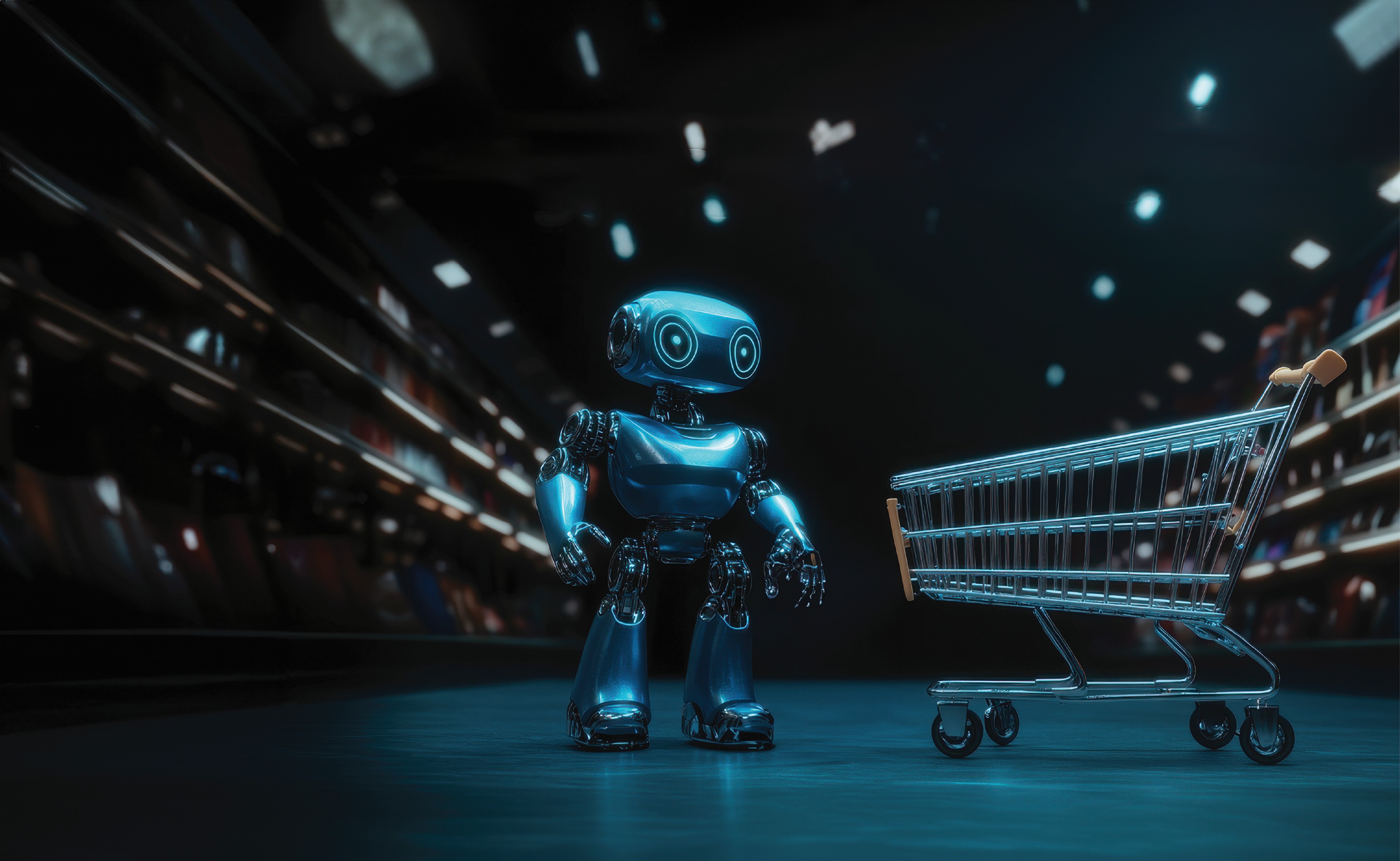
A busy executive walks into a department store after work. Their phone instantly notifies them about carefully curated business attire that perfectly matches an upcoming business trip, accounting for the destination's weather forecast. A store associate already has these selections waiting in the fitting room. Behind this seamless experience is an autonomous, Agentic AI system connecting inventory, weather data, purchase history, and calendar information without human oversight. These powerful Agentic AI trends in retail represent the industry's biggest technological leap since e-commerce.
This scenario unfolds today in 43 percent of retail organizations already piloting autonomous AI systems (Source: EMARKETER). These intelligent systems, Agentic AI, represent retail's biggest technological leap since e-commerce. Traditional AI tells you what might happen. Agentic AI takes action. These systems don't wait for approval to reorder inventory, adjust pricing, or resolve customer issues. They operate across your entire business, from supply chain to storefront.
For retailers facing margin pressure and aggressive competition, this capability changes the game. Systems that predict what customers want, manage inventory levels, and run operations 24/7 aren't just nice to have anymore. They're becoming essential for staying competitive in today's retail environment.
This article explores how these powerful Agentic AI trends in retail are transforming the industry in 2025 and what it means for businesses and consumers alike.
Understanding the Concept of Agentic AI in Retail
Think of an employee who never sleeps, remembers every customer interaction perfectly, and makes consistent decisions based on business rules. That is Agentic AI in essence.
Conventional AI systems operate reactively. They analyze data, make recommendations, and await human instructions. Agentic AI completes this loop independently by taking action without constant supervision.
In retail contexts, Agentic AI functions as an independent digital worker that can:
- Navigate multiple systems seamlessly
- Access various tools and data sources
- Execute complex sequences of actions
- Achieve specific business goals without human intervention
For example, while a standard AI chatbot answers customer questions using predefined responses, an Agentic retail AI identifies issues, accesses inventory systems, initiates refunds, suggests alternatives, and proactively contacts customers with personalized offers without human involvement.
Five core elements define true Agentic AI in retail:
- Goal orientation: Works toward specific retail objectives like optimizing inventory or personalizing customer experiences
- Adaptive planning: Learns from interactions and adjusts strategies based on changing circumstances
- Autonomy: Operates independently within defined parameters
- Tool access: Utilizes systems, APIs, databases, and software tools to accomplish tasks
- Continuity of execution: Maintains effectiveness despite disruptions through backup plans and adaptive strategies
This shift from reactive to proactive, from analysis to action, transforms retail operations. These systems do not simply inform human decisions; they independently execute complex operations across the entire customer journey and supply chain.
Five Agentic AI Trends in Retail That Are Dominating
The shift to agentic AI isn't theoretical anymore. Leading retailers are already deploying these systems across their operations, with clear patterns emerging about what works and where the biggest impacts occur.
Here are five agentic AI trends in retail where we can see measurable results today:
1. Autonomous Shopping Assistants Evolving Beyond Basic Recommendations
Simple product recommendations are giving way to fully autonomous shopping assistants functioning as personal retail agents. 39 percent of shoppers are already exploring AI in their shopping journeys, with this figure rising to 54 percent among Gen Z consumers (Source: Salesforce).
These assistants search across retailers, compare prices, monitor promotions, complete purchases with minimal input, and continuously adapt to preferences. Amazon is developing proactive shopping companions beyond recommendation engines (Source: Pymnts).
Research shows 70 percent of shoppers want AI agents optimizing loyalty points, with strong interest in customer service automation (Source: EMARKETER). With Gen Z shoppers 10 times more likely than baby boomers to use AI for discovery, retailers must adapt or risk irrelevance.
Tredence's Customer Cosmos platform enables these personalized experiences through unified customer data and real-time behavioral insights.
2. Supply Chain Orchestration Through Multi-Agent Systems
This agentic AI trend in retail is the most transformative application of Agentic AI. It happens behind the scenes with specialized AI agents collaborating across supply chain operations. These networks include inventory optimization, demand forecasting, logistics, procurement, and risk management agents working in concert.
Beyond identifying issues, these agents act like enterprising co-workers, taking initiative to achieve outcomes without explicit instructions (Source: SymphonyAI). Picture this: a shipping delay hits your West Coast distribution center. Instead of scrambling to react, your AI agents spring into coordinated action. The forecasting agent updates demand predictions, the inventory agent redirects stock from other locations, and the procurement agent adjusts upcoming orders. All this happens in minutes, not days.
Tredence's Supply Chain Control Tower brings this capability to life. It gives you complete visibility across your supply chain while automating the complex decisions that keep products flowing smoothly to stores and customers.
3. Hyper-Personalization Through Continuously Learning Agents
Agentic retail AI transforms rigid personalization into systems that continuously learn and adapt at an individual level. With 37 percent of consumers comfortable with AI creating personalized content (Source: Salesforce), retailers now deploy sophisticated systems that process hundreds of data points per customer.
These systems analyze purchase history and browsing behavior, test personalization approaches independently, and adapt to changing customer behaviors without human intervention. When life events like moving homes occur, the agentic system recognizes these shifts independently and adjusts without requiring analysts to create new rules or segments.
4. Store Operations Optimization Through Autonomous Management
Physical retail stores are being transformed by Agentic AI systems that continuously optimize operations across staffing, layout, inventory positioning, and customer service in real-time.
MediaMarktSaturn's MyBuddy AI agent enables associates to "shop" the catalog for customers, boosting confidence and enhancing product knowledge (Source: Microsoft). These systems optimize store layouts, identify underperforming areas, adjust electronic shelf pricing, and coordinate staff scheduling, executing changes rather than simply making recommendations.
5. Autonomous Merchandising and Planogram Design
Visual merchandisers traditionally spend weeks designing floor plans. Agentic AI now handles this process in hours by analyzing footfall data, product performance, and weather forecasts to execute shelf arrangements across store networks.
AI agents detect planogram compliance issues that contribute to underperformance, autonomously generating restock orders, recommending assortment changes, and refining promotions without constant oversight. By maintaining an "always on" approach, these agents address performance issues much faster than legacy processes with infrequent reviews.
These five agentic AI trends in retail make one thing clear: agentic AI changes the rules of retail. Every part of the business works differently when systems can think and act on their own.
Retailers who wait to adopt these technologies will find themselves competing against businesses that never sleep, never forget a customer preference, and never miss an optimization opportunity. The early movers are already pulling ahead.
Are We Ready for the Agentic AI Change in the Retail Industry
Moving this fast comes with real challenges. Retailers are rushing to implement the latest agentic AI trends in retail, but many are unprepared for what it entails. Consumers, meanwhile, have their own concerns about trusting machines with their shopping decisions.
Key readiness challenges for retailers:
- Data infrastructure gaps: Agentic AI systems require comprehensive, high-quality data across multiple systems. 81 percent of retailers say inefficient processes and technology drain store associate productivity, highlighting the technical debt that must be addressed. (Source: Salesforce)
- System integration needs: Legacy systems not designed for AI integration create barriers to implementation. Fortunately, 86 percent of retailers have unified commerce initiatives underway, creating the connected foundation that Agentic AI requires. (Source: Salesforce)
- Expertise shortages: 76 percent of retailers plan to increase investment in AI within the next year, but many lack the internal expertise to effectively implement and manage these systems. (Source: Small Business Trends)
Consumer readiness barriers:
- Trust concerns: Only 24 percent of consumers are currently comfortable sharing data with an AI shopping tool, according to research from eMarketer and CivicScience. (Source: EMARKETER)
- Privacy worries: Consumers remain concerned about how their data will be used and protected.
- Control preferences: Many shoppers want to maintain some level of control over the shopping process.
To build consumer trust, retailers must focus on:
- Strong privacy protections and security measures
- Clear opt-in/opt-out mechanisms for AI assistance
- Requiring explicit consumer approval for purchases
- Transparency around data usage practices
- Providing human customer service backup options
Tredence's Agentic AI framework helps retailers address these challenges by delivering self-learning AI agents that automate decision workflows, adapt dynamically to changing conditions, and operate autonomously within clearly defined parameters.
Despite these challenges, forward-thinking retailers are already utilizing the Agentic AI trends in retail and developing roadmaps for a massively agentic future, with several key developments poised to shape the industry in the coming years
A Look At the Future of Retail Agentic AI
Looking toward 2026 and beyond, several emerging trends suggest how Agentic AI will continue to transform retail as the technology matures and adoption increases.
|
Future Trend |
Description |
Potential Impact |
|
Human-AI Collaboration |
Rather than replacing human retail associates, AI will augment human capabilities. 68 percent of sales teams with AI added headcount in the past year, compared to 47 percent of teams without AI. (Source: Salesforce) |
Enhanced customer service, higher employee productivity, and more satisfying work for retail associates |
|
Multi-Agent Ecosystems |
2025 will be the year multi-agent systems take center stage, moving beyond single-agent applications. Retailers will implement interconnected systems of specialized agents that collaborate. |
More sophisticated problem-solving, smoother operations across departments, faster response to complex issues |
|
Physical-Digital Integration |
As sensors, cameras, and IoT devices proliferate in stores, agentic systems will gain unprecedented visibility into the physical world. |
Truly unified commerce experiences, seamless blending of online and offline interactions, and better inventory visibility |
|
Voice-Native Retail Agents |
By 2026, voice will replace typing for many mobile commerce actions. Retailers will invest in voice-native agents that understand context, accents, and customer history. |
More natural and accessible AI support, reduced friction in mobile commerce, increased convenience |
|
Goal-Based Shopping |
Instead of browsing categories, customers will set goals like "Buy everything I need for a keto meal plan under $50," and AI agents will handle the selection process. |
Time savings for consumers, increased basket size, and higher customer satisfaction |
The long-term vision suggests a retail landscape where Agentic AI forms the operational backbone of the industry. The AI in the retail market is expected to reach USD 13.07 billion in 2025 and grow at a CAGR of 32.68 percent to reach USD 53.74 billion by 2030, indicating the significant economic impact this transformation will have across the industry. (Source: Mordorintelligence)
With such significant growth on the horizon, retailers must determine how they will participate in this transformation and what partners can support them in the journey.
The Tredence Advantage: Turning Agentic AI Concepts into Retail Success Stories
Agentic AI represents the next frontier in retail technology, moving beyond analysis to autonomous action and beyond reactive responses to proactive management. The agentic AI trends in retail highlighted in this article illustrate how these systems are already transforming retail operations across customer interactions, supply chain management, personalization, and store operations.
Yes, there are hurdles. Data systems need upgrades, consumers need convincing, and teams need training. But early adopters are already seeing better margins, happier customers, and smoother operations. Their success is forcing everyone else to move faster.
Retail leaders can't treat agentic AI as tomorrow's technology anymore. It's here, it's working, and competitors are already using it to gain an edge. Organizations that begin building the foundations now will be best positioned to thrive as autonomous systems become the industry standard.
Companies like Tredence are at the forefront of this transformation, helping retailers implement agentic AI solutions across their operations. With capabilities ranging from autonomous decision-making frameworks to AI-powered supply chain control towers and advanced customer personalization platforms, Tredence enables retailers to convert the promise of Agentic AI into tangible business outcomes.
Do not fall behind in the Agentic AI revolution. Contact Tredence today to discover how their cutting-edge solutions can transform your retail operations, enhance customer experiences, and drive sustainable growth in an increasingly autonomous future.
FAQs
Are big retail brands already investing in Agentic AI platforms?
Yes, major retail brands are actively investing in Agentic AI platforms. According to Salesforce's Connected Shoppers Report, 43 percent of retailers currently pilot autonomous AI systems, with another 53 percent evaluating potential implementations. (Source: EMARKETER) Companies like Walmart, Amazon, Microsoft, and Salesforce lead this adoption, deploying agentic systems across customer service, inventory management, supply chain optimization, and personalization.
What makes Agentic AI more "independent" than other forms of AI?
Agentic AI differs from traditional AI in five key ways: goal orientation (working toward specific objectives), adaptive planning (learning and adjusting strategies), autonomy (operating independently), tool access (utilizing various systems and resources), and continuity of execution (maintaining effectiveness despite disruptions). While conventional AI systems analyze data and make recommendations, Agentic AI can independently execute complex sequences of actions across multiple systems without constant human direction.
How do Agentic AI agents help with in-store personalization or mobile apps?
Agentic AI transforms in-store personalization and mobile experiences by creating truly adaptive, contextual interactions. In physical stores, AI agents enable store associates to navigate product catalogs more effectively, boosting customer confidence and enhancing employees' product knowledge. For mobile apps, Agentic AI creates experiences that adapt in real-time to user behavior, location, and context, continuously learning from interactions and autonomously adjusting their approach based on what resonates with each customer.

AUTHOR - FOLLOW
Editorial Team
Tredence




